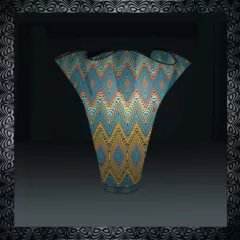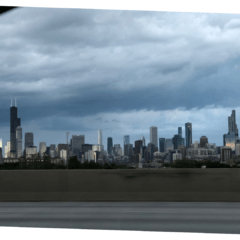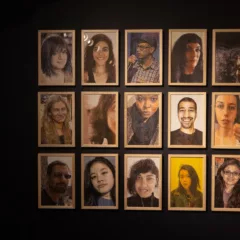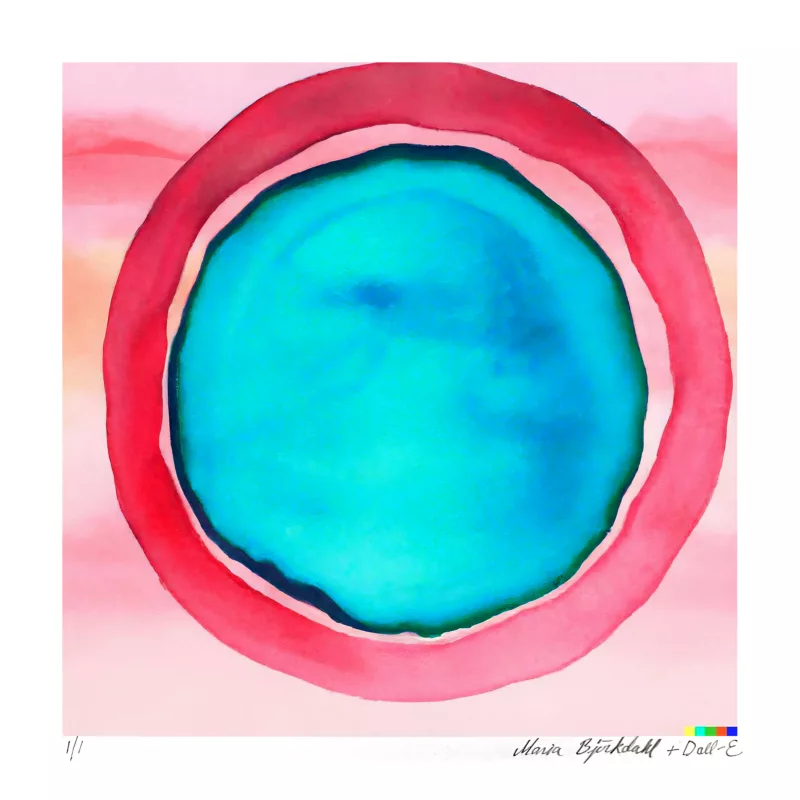
Is AI-generated art the “new” genre in the continual pendulum of the Avant-Garde vs the Academy?
Looking back –
Artists got on the soapbox glorifying industrialization and technology, with Monet’s series of smoky train stations back in 1877. Then in 1909, The Futurist Manifesto proclaimed “the roaring car… is more beautiful than the Victory of Samothrace.”
What followed was a repeated redefinition of the avant-garde through Impressionism, Cubism, Dada (R. Mutt 1917), the Bauhaus, Abstract Expressionism, POP, to conceptual earthworks complete with documentation and a video, to research-based information art.
Now it’s AI’s turn.
Yet art is still wearing the same old pair of jeans (wink, wink to the academy).
I looked at the Chimaera show, AI: The Next Evolution, a virtual exhibition.
Viewing the imagery was like a scene in “Walden Two” (B.F. Skinner, 1948), utopia – sterile and manipulative, and a bit sinister.
I kept wondering when the amygdala would break out and scream for life with adrenaline.
Painting is a verb, an action.
AI is a tool.
It is a “computer science that develops programs to allow machines to perform functions normally requiring human intelligence”. (This is the computer Dictionary definition.)
AI can only spew out permutations of what was downloaded.
uploaded by programmers.
To do a good job it is important to have the right tools and know how to use them to get the results you want. The tool is not the result.
The question is – what is the intention of the artists using this tool?
“AI: The Next Evolution I don’t get it, and while the statements were interesting, they were just more “artspeak”. And after a while (a very short while) I found the sci-fi virtual reality show to be a slick-trick special effect time suck. The tool is not the result.
One exception – Maria Bjorkdahl, who addresses the machine vs the hand. She qualifies the machine as ubiquitous and anonymous, and the hand as personal and unique. She writes about first painting an image.
The next question – is this swing of the aesthetic pendulum beneficial for art, for society, for humanity?
Just the phrase “artificial intelligence” is enough to throw me off balance.
Artificial – it derives from the Latin artificium meaning cunning. It is defined as an imitation of something natural, without sincerity or spontaneity.
While intelligence implies perception, and development through experience.
What art is is something that is natural, sincere and spontaneous.
Art made with artificial intelligence cannot be natural, sincere and spontaneous.
Artificially manufactured “art” can only be a reproduction, a technical manipulation, a clone.
Art asks us to look and teaches us to see. Viewing art is an aesthetic experience. When art asks us to look, art also asks us to analyze our perceptions, to get in touch with our gut.
Unfortunately it is too much time spent on the screen and the lack of art education that channels viewers to perceive AI as an art experience.
It is entertainment, transitory cheap thrills.
One of the dangers in this scenario is technological surveillance, recording data on viewing habits. AI algorithms categorize viewers into types and analyze perception – what we look at and for how long. It then uses this data to manipulate what is shown, what will be seen next on the screen –
inculcating manufactured information into an anesthetized brain. Big Brother is watching.
Meetings are currently underway to study how to implement safeguards concerning the ability of the AI tool to trick people and disseminate false information.
Another issue, currently in the film industry, AI presents a danger to artists’ jobs and livelihoods. Look at the 3 month plus writer’s strike. AI is a big issue in the writers’ negotiations. AI affects both pre and post production. In an on-line interview on Apple News (08-04-2023), graphic artist Carla Ortez, who worked on Marvel blockbusters, said “It (artificial intelligence) took away my consent to being part of the technology, no one will know that my work powered those images… it’s not a hypothetical, it’s happening right now, it’s existential for us, really.”
Yet another even bigger danger is the continued defunding of art education, and education in general, and book banning, and rewriting history and …
Do art – take a class and support your local art center.
Making art encourages critical thinking.
It uplifts the individual. It develops problem solving skills.
Engage… when art experiences are shared, talking about what we see and feel and listening to other people’s observations connects us.
Human creativity will continue to expand through AI into new realms of object making.
AI is a tool, not a solution. If it is allowed to take over the job of problem solving, the “artist” becomes part of this collective intellectualized algorithmic machine. The individual is erased.
Read Artblog’s two other essays on AI:
A Short Walk through the Uncanny Valley of AI Art by Clayton Campbell and
The Imitation Game – an Artist’s Role in Latent Space by Lane Speidel.
Your Brain on Art, How the Arts Transform Us
By Susan Magasmen and Ivy Ross
Book Review By Ruth Wolf
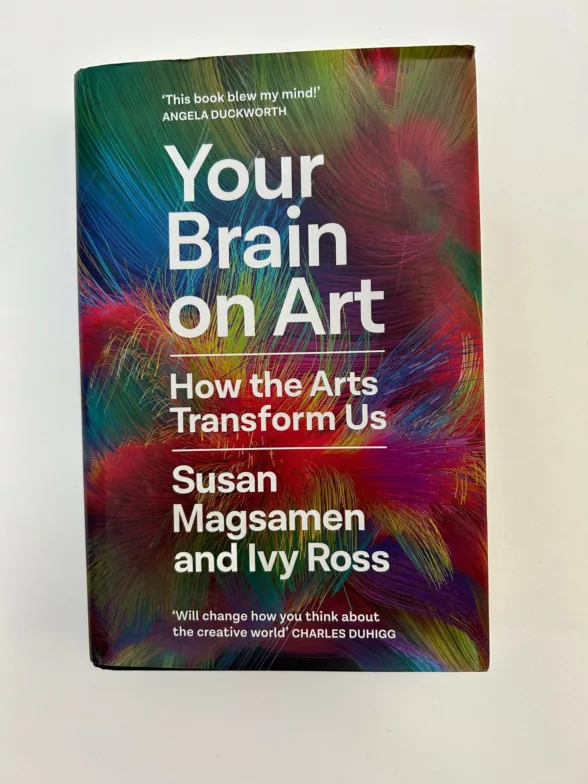
Susan and Ivy state in their book that “one or more art experiences a month can extend your life by 10 years”.
What is art, what is the purpose of art and how is it being defined in
Your Brain on Art.
Here art is presented as a therapeutic tool, where “the object created is no longer the goal”.
The book starts by explaining the brain‘s “default network” – “the neurological basis for the self”. “Your perception is your reality” – your environment, your physical responses and your emotions – stimuli.
Susan and Ivy describe how the brain processes stimuli.
They acknowledge the power of the arts as a potent stimuli. They cite numerous studies that quantify brain function and how art is used to generate stimuli.
Art used for studying brain function is referred to as the neuroarts or neuroaesthetics.
In the book, I read about neuroplasticity – the brains ability to re-wire and adapt synaptic circuits that process response to experience, the key to learning and forming memory.
This is all interesting stuff.
In the book, I read about enriched environments, nature being the ultimate manifestation.
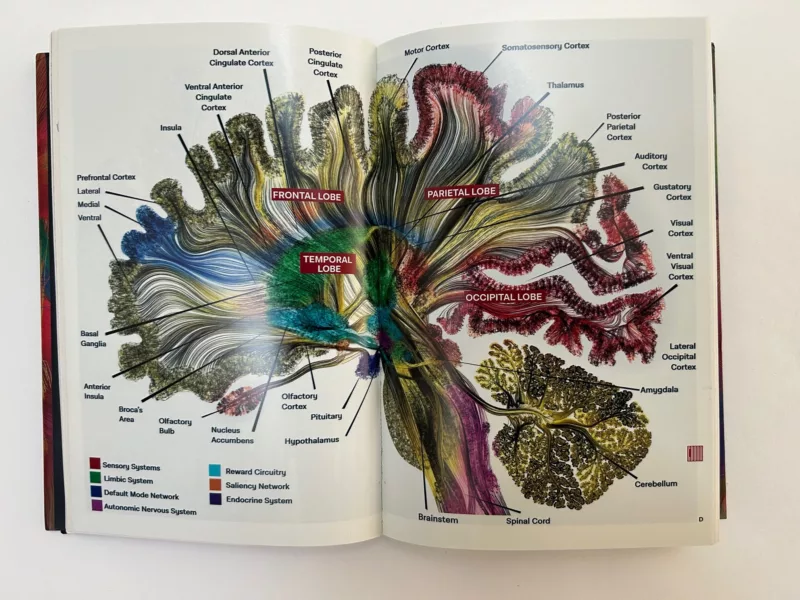
I found the large, two-page color diagram of the brain fascinating and referred to it many times.
I read about research using art to treat people suffering with trauma, PTSD, ADHD, dementia, nature deficit disorder, physical pain.
Susan and Ivy relate stories about how making things, dancing, playing and/or listening to music, poetry, stories; how having an aesthetic experience helps people heal and instills an aura of well being.
Another premise presented is how the visual arts, a language without words, can help process complex emotions for which words cannot be found.
As visual artists, we intrinsically know this.
What is it about the visual arts that makes it such an important tool for emotional and sensory research – for sensory awareness. Susan and Ivy equate sensory awareness as aesthetics. I feel this is a bit of a stretch.
As artists we are first taught how to see, to be aware. We spend hours describing in detail nuances of light and line in order to produce an object.
Is the aesthetic experience (art), the process or is it the object.
If the process of doing art is used as a tool to soothe the tormented mind, then why do so many artists get tormented by doing art, censor their art, erase their art. Can getting in touch with the self and expression; can expressing it (sensory awareness) into a tangible language flip, and you, the artist, are thrust into the depths of the rabbit hole? Does society cherishes this vulnerability in its artists and performers?
There is only one brief reference made to the entire “class” of people (the art maker) where doing art, being committed to the work, is acknowledged as a stress generator (“production pressure”) .
Working within an art practice, the demands for performance and sales, how do you address aesthetic burnout.
Life is unpredictable. It is full of stresses, insecurities and exhaustion.
Is the prescription for a psychological utopia ART.
Or is it a playbook for mind control, and creating a homogeneous Western rationalization.
This is a thought provoking and enjoyable read.


